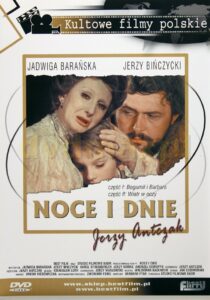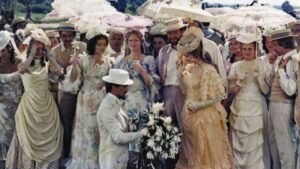“Nights and Days” – Polish “Gone with the Wind”

Title: “Nights and Days” (“Noce i dnie”)
Release Date: 1974
Director: Jerzy Antczak
Cast: Jadwiga Barańska, Jerzy Bińczycki, Elżbieta Starostecka, Władysław Hańcza, Karol Strasburger, Stanisława Celińska, Jerzy Kamas, Olgierd Łukaszewicz, Janina Traczykówna, etc.
Jerzy Antczak’s adaptation of Maria Dabrowska’s famous novel “Noce i dnie” is undoubtedly outstanding. It is a film of great epic momentum, with superb acting and picturesque panoramas of the Polish landscape. The masterpiece of our Polish cinematography has also gained international recognition. An American film critic dubbed “Nights and Days” the Polish “Gone with the Wind”.
“Nights and Days” is Maria Dąbrowska’s literary masterpiece. In her multi-volume family saga, inspired by autobiographical themes, the writer created an exceptionally rich picture of Polish society against the backdrop of groundbreaking historical events. The tragic fate of the January Uprising, the 1905 revolution and World War I, and on the other hand, the birth of the Polish intelligentsia or emancipation movements – all this was reflected in Dąbrowska’s multidimensional epic. When Jerzy Antczak undertook the adaptation of the famous novel, he faced an extremely difficult task. Nevertheless, he came out victorious.
“Nights and Days” was produced on a grand scale: five hundred days of shooting, nine hundred actors, nineteen thousand costumes – all this resulted in a true masterpiece. In the foreground, Antczak placed an unforgettable couple in Polish cinema – Barbara and Bogumił Niechcic, that is Jadwiga Barańska and Jerzy Bińczycki. It is their relationship that is at the center of the film world, shifting the focus from social and national issues to excellent acting performances. “Nights and Days” by Antczak is the story of Barbara and Bogumił’s relationship shown in retrospect. The narrative framework of the story is created by the scene of Mrs. Niechcicowa escaping from the war-stricken Kaliniec. During the journey the elderly woman recalls her whole life.

In subsequent scenes we see the youthful love of the poor noblewoman for the handsome Józef Toliboski. Later it turns out that the beloved married a wealthier maiden, and Barbara marries Bogumił, a former insurgent from the January Uprising, out of common sense. Together they lease a succession of landed estates (Serbinów), which Bogumił brings to prosperity thanks to his love for the land and his resourcefulness. The couple survived the tragic death of their little son Piotr, and then the birth of their children: Agnieszka, Emilka and Tomaszek. Barbara’s days are filled with “eternal worry” – everyday small and bigger worries. The children grow up and acquire new levels of education. Meanwhile, the dishonest owner of Serbinów sells the estate and the Niechcic family is forced to leave their beloved land. They manage to buy a small piece of land, Pamiętów, but the heartbroken Bogumił deteriorates and dies. Barbara is left alone in Kaliniec when World War I breaks out. The woman leaves town on the old Jew Szymszel’s cart in search of shelter.
“Nights and Days” – outstanding acting performances
The leading roles in “Nights and Days” are some of the best performances in the history of Polish cinema. Completely different types of personalities create a fascinating duet on screen. Jadwiga Barańska created a great portrait of a woman whose personal charm coexists with a hysterical nature and philosophical reverie. Barbara is an incorrigible dreamer whose entire life passes in the shadow of an unhappy youthful love complex. The leitmotif of the film is the famous scene with water lilies, when Józef Toliboski (played by Karol Strasburger) in a white dress enters the lake to collect flowers and lay them at the feet of his beloved. The scene was set to beautiful, nostalgic music by Waldemar Kazanecki.
On the other hand, Jerzy Bińczycki perfectly played the role of steady Bogumił, in love with his wife, devoted to his family and peaceful work on the land. Both performances were awarded with prestigious distinctions. Barańska received the Silver Bear at the Berlin Festival, while both actors won the Main Acting Awards at the Gdańsk Festival.

Artistry of “Nights and Days”
Although Antczak’s “Nights and Days” does not exhaust the rich ideological issues of Dąbrowska’s novel, it remains an outstanding work of Polish cinema. At the Berlin Festival the film received the UNICRIT World Critics’ Award, and was nominated for an Oscar. What is more, in 2002 the film was included in the list of six titles of The American Cinematiqnaue (Archive of the Film Academy) representing “The Golden Age of Films Made on the 70mm Film”. “Nights and Days” ranked alongside such works as “Ben Hur”, “Around the World in 80 Days”, “2001: A Space Odyssey”.
The adaptation of Dąbrowska’s novel is visually and sonically stunning. It is a wonderful nostalgic picture of a bygone world: Polish history and Polish nobility, which gave birth to the formation of the intelligentsia. The technique of photography used in the film is worth noting. We are dealing here with panoramic frames that portray the native landscapes in reference to the paintings of the greatest landscape painters. The rich colors, wonderful music and rhythm of the narrative reflect Bergson’s admiration for the dynamic nature of life, in which everything is constantly “going on and on”.
“Nights and Days” and “Gone with the Wind”
“Nights and Days” is thererore an unusually epic film in which the most salient national traits (somewhat idealized) and historical references flicker in the background of a great love story. For this reason, among others, American critic Kevin Thomas called Antczak’s film “Polish Gone with the Wind” in the “Los Angeles Times”. In “The New York Times”, he wrote:
“To all those who thought there would never be another Gone with the Wind, I refer you to the Polish film “Nights and Days”. In its momentum it equals such works as War and Peace or Doctor Zhivago”.
Ł. Maciejewski, “Aktorki”, Kraków 2015.
A. Garbicz, “Kino, wehikuł magiczny. Przewodnik osiągnięć filmu fabularnego. Podróż piąta” 1974 – 1981”, Kraków 2009.

